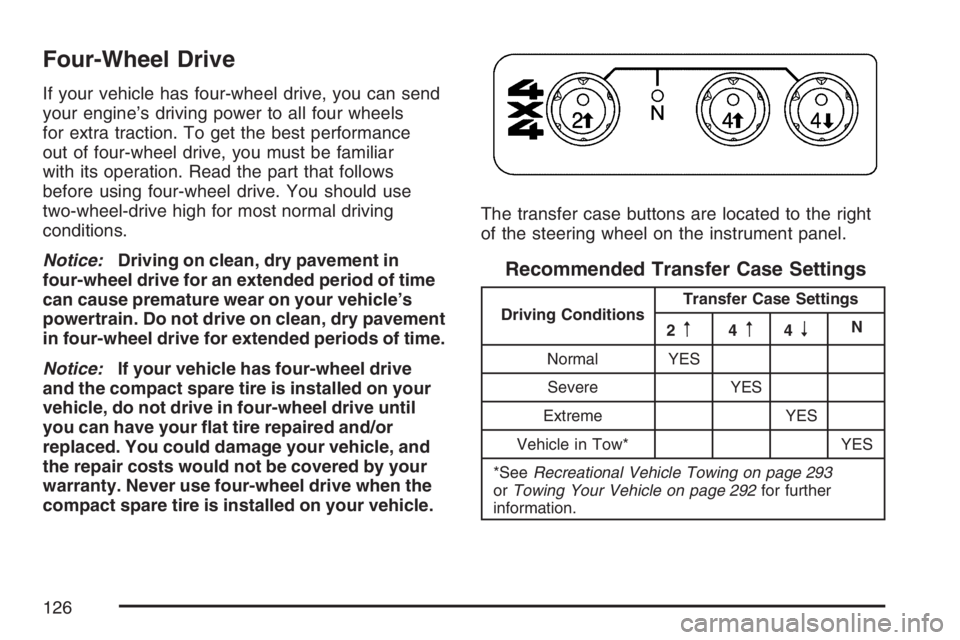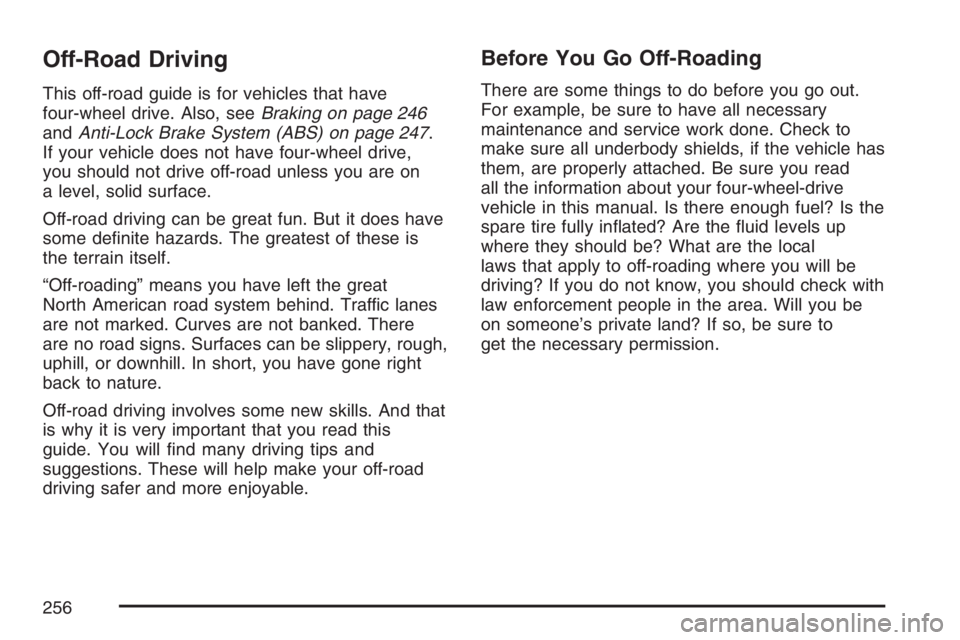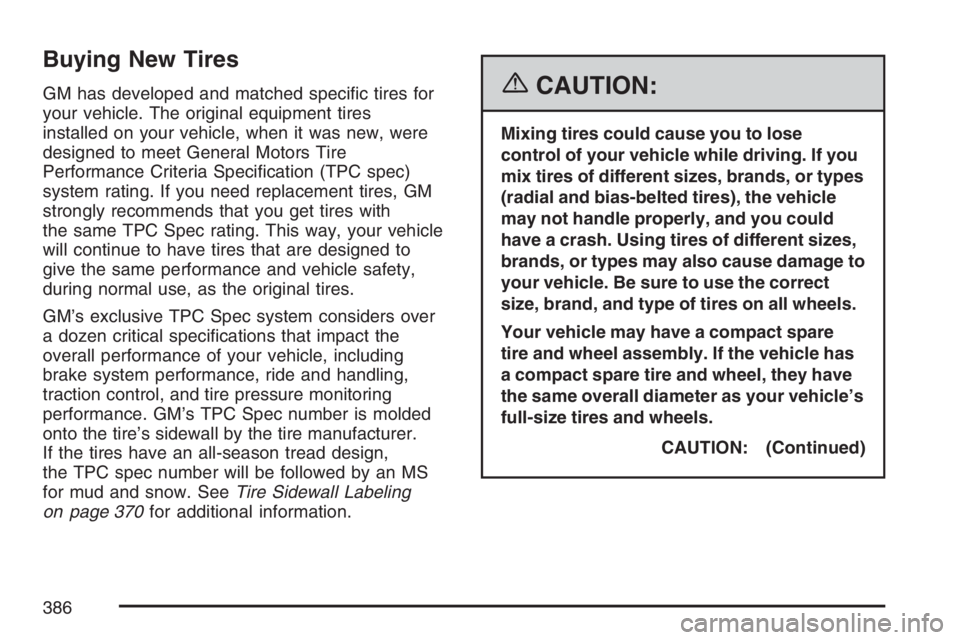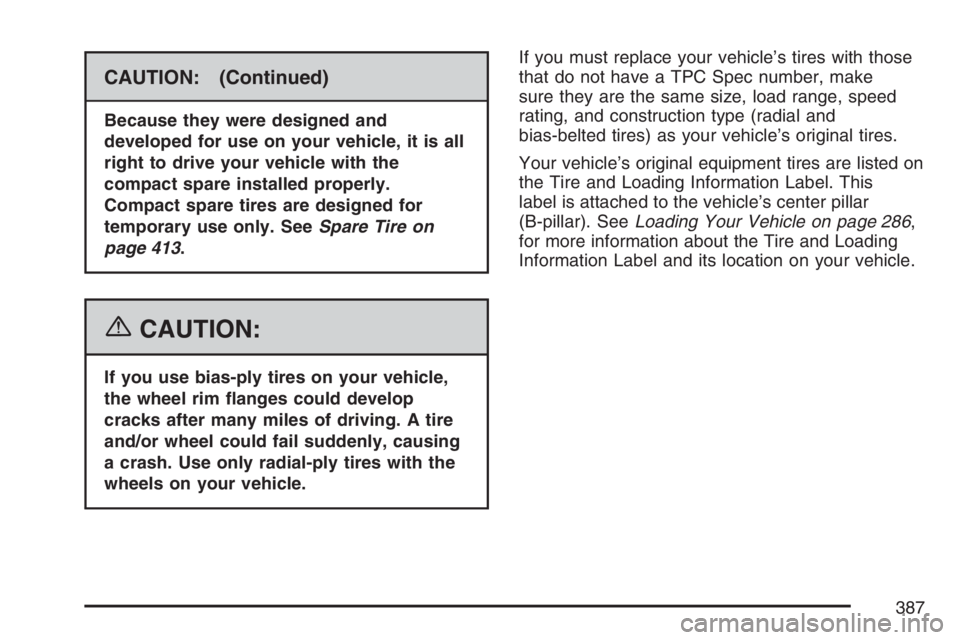2007 GMC CANYON spare wheel
[x] Cancel search: spare wheelPage 126 of 492

Four-Wheel Drive
If your vehicle has four-wheel drive, you can send
your engine’s driving power to all four wheels
for extra traction. To get the best performance
out of four-wheel drive, you must be familiar
with its operation. Read the part that follows
before using four-wheel drive. You should use
two-wheel-drive high for most normal driving
conditions.
Notice:Driving on clean, dry pavement in
four-wheel drive for an extended period of time
can cause premature wear on your vehicle’s
powertrain. Do not drive on clean, dry pavement
in four-wheel drive for extended periods of time.
Notice:If your vehicle has four-wheel drive
and the compact spare tire is installed on your
vehicle, do not drive in four-wheel drive until
you can have your �at tire repaired and/or
replaced. You could damage your vehicle, and
the repair costs would not be covered by your
warranty. Never use four-wheel drive when the
compact spare tire is installed on your vehicle.The transfer case buttons are located to the right
of the steering wheel on the instrument panel.
Recommended Transfer Case Settings
Driving ConditionsTransfer Case Settings
2m4m4nN
Normal YES
Severe YES
Extreme YES
Vehicle in Tow* YES
*SeeRecreational Vehicle Towing on page 293
orTowing Your Vehicle on page 292for further
information.
126
Page 256 of 492

Off-Road Driving
This off-road guide is for vehicles that have
four-wheel drive. Also, seeBraking on page 246
andAnti-Lock Brake System (ABS) on page 247.
If your vehicle does not have four-wheel drive,
you should not drive off-road unless you are on
a level, solid surface.
Off-road driving can be great fun. But it does have
some de�nite hazards. The greatest of these is
the terrain itself.
“Off-roading” means you have left the great
North American road system behind. Traffic lanes
are not marked. Curves are not banked. There
are no road signs. Surfaces can be slippery, rough,
uphill, or downhill. In short, you have gone right
back to nature.
Off-road driving involves some new skills. And that
is why it is very important that you read this
guide. You will �nd many driving tips and
suggestions. These will help make your off-road
driving safer and more enjoyable.
Before You Go Off-Roading
There are some things to do before you go out.
For example, be sure to have all necessary
maintenance and service work done. Check to
make sure all underbody shields, if the vehicle has
them, are properly attached. Be sure you read
all the information about your four-wheel-drive
vehicle in this manual. Is there enough fuel? Is the
spare tire fully in�ated? Are the �uid levels up
where they should be? What are the local
laws that apply to off-roading where you will be
driving? If you do not know, you should check with
law enforcement people in the area. Will you be
on someone’s private land? If so, be sure to
get the necessary permission.
256
Page 314 of 492

Bulb Replacement....................................... 361
Halogen Bulbs........................................... 361
Headlamps................................................ 362
Front Turn Signal, Parking and
Daytime Running Lamps (DRL).............. 363
Center High-Mounted Stoplamp (CHMSL) ... 364
Taillamps, Turn Signal, Stoplamps and
Back-up Lamps...................................... 364
License Plate Lamp................................... 366
Replacement Bulbs................................... 366
Windshield Wiper Blade Replacement....... 367
Tires............................................................ 369
Tire Sidewall Labeling............................... 370
Tire Terminology and De�nitions............... 374
In�ation - Tire Pressure............................. 377
Tire Pressure Monitor System................... 378
Tire Inspection and Rotation...................... 383
When It Is Time for New Tires.................. 385
Buying New Tires...................................... 386
Different Size Tires and Wheels................ 388
Uniform Tire Quality Grading..................... 389
Wheel Alignment and Tire Balance............ 390
Wheel Replacement.................................. 390Tire Chains............................................... 392
If a Tire Goes Flat.................................... 393
Changing a Flat Tire................................. 394
Removing the Spare Tire and Tools.......... 395
Removing the Flat Tire and
Installing the Spare Tire......................... 398
Secondary Latch System........................... 406
Storing a Flat or Spare Tire and Tools...... 410
Spare Tire................................................. 413
Appearance Care........................................ 415
Cleaning the Inside of Your Vehicle.......... 415
Fabric/Carpet............................................. 416
Leather...................................................... 417
Instrument Panel, Vinyl, and
Other Plastic Surfaces........................... 418
Care of Safety Belts.................................. 418
Weatherstrips............................................ 418
Washing Your Vehicle............................... 419
Cleaning Exterior Lamps/Lenses................ 419
Finish Care............................................... 419
Windshield and Wiper Blades.................... 420
Aluminum or Chrome-Plated Wheels......... 421
Tires......................................................... 422
Section 5 Service and Appearance Care
314
Page 378 of 492

How to Check
Use a good quality pocket-type gage to check tire
pressure. You cannot tell if your tires are
properly in�ated simply by looking at them. Radial
tires may look properly in�ated even when they
are underin�ated. Check the tire’s in�ation
pressure when the tires are cold. Cold means your
vehicle has been sitting for at least three hours
or driven no more than 1 mile (1.6 km).
Remove the valve cap from the tire valve stem.
Press the tire gage �rmly onto the valve to
get a pressure measurement. If the cold tire
in�ation pressure matches the recommended
pressure on the Tire and Loading Information
label, no further adjustment is necessary. If the
in�ation pressure is low, add air until you reach the
recommended amount.
If you over�ll the tire, release air by pushing on
the metal stem in the center of the tire valve.
Recheck the tire pressure with the tire gage.
Be sure to put the valve caps back on the valve
stems. They help prevent leaks by keeping out dirt
and moisture.
Tire Pressure Monitor System
Your vehicle has a Tire Pressure Monitor System
(TPMS). This system uses radio and sensor
technology to check tire pressure levels. TPMS
sensors are mounted onto each tire and wheel
assembly on your vehicle, except the spare tire.
The TPMS sensors monitor the air pressure
in your vehicle’s tires and transmit the tire pressure
readings to a receiver located in the vehicle.
When a low tire pressure condition is detected,
the TPMS will illuminate the low tire pressure
warning light located in the instrument panel
cluster, and at the same time display the LOW
TIRE warning message on the Driver Information
Center (DIC). The low tire pressure warning
light and the LOW TIRE warning message appear
at each ignition cycle until the tires are in�ated
to the correct in�ation pressure.
378
Page 383 of 492

Federal Communications Commission
(FCC) and Industry and Science Canada
The Tire Pressure Monitor System (TPMS)
operates on a radio frequency and complies with
Part 15 of the FCC Rules. Operation is subject
to the following two conditions:
1. This device may not cause harmful
interference.
2. This device must accept any interference
received, including interference that may
cause undesired operation.
The Tire Pressure Monitor System (TPMS)
operates on a radio frequency and complies with
RSS-210 of Industry and Science Canada.
Operation is subject to the following two
conditions:
1. This device may not cause interference.
2. This device must accept any interference
received, including interference that may
cause undesired operation of the device.
Changes or modi�cations to this system by other
than an authorized service facility could void
authorization to use this equipment.
Tire Inspection and Rotation
Tires should be rotated every 5,000 to 8,000 miles
(8 000 to 13 000 km).
Any time you notice unusual wear, rotate your
tires as soon as possible and check wheel
alignment. Also check for damaged tires or wheels.
SeeWhen It Is Time for New Tires on page 385
andWheel Replacement on page 390for
more information.
Make sure the spare tire is stored securely. Push,
pull, and then try to rotate or turn the tire. If it
moves, use the wheel wrench to tighten the cable.
SeeChanging a Flat Tire on page 394.
The purpose of regular rotation is to achieve more
uniform wear for all tires on the vehicle. The
�rst rotation is the most important, seeScheduled
Maintenance on page 437.
383
Page 384 of 492

When rotating your tires, always use one of the
correct rotation patterns shown here.
If your vehicle has a compact spare tire or a spare
tire that does not match your vehicle’s road tires
and wheels, in size and type, do not include
the spare in the tire rotation.
After the tires have been rotated, adjust the front
and rear in�ation pressures as shown on the
Tire and Loading Information label. For the location
of the Tire and Loading Information label see
Loading Your Vehicle on page 286. Make certain
that all wheel nuts are properly tightened, see
“Wheel Nut Torque” underCapacities and
Speci�cations on page 430for the proper wheel
nut torque speci�cation.
{CAUTION:
Rust or dirt on a wheel, or on the parts to
which it is fastened, can make wheel nuts
become loose after time. The wheel could
come off and cause an accident. When
you change a wheel, remove any rust or
dirt from places where the wheel attaches
to the vehicle. In an emergency, you can
use a cloth or a paper towel to do this;
but be sure to use a scraper or wire brush
later, if needed, to get all the rust or dirt
off. SeeChanging a Flat Tire on page 394.
Any time you rotate the vehicle’s tires the Tire
Pressure Monitor System (TPMS) will need to be
reset. The TPMS identi�cation codes will need
to be matched to the tire and wheel position. See
“TPMS Sensor Identi�cation Codes” underTire
Pressure Monitor System on page 378.
384
Page 386 of 492

Buying New Tires
GM has developed and matched speci�c tires for
your vehicle. The original equipment tires
installed on your vehicle, when it was new, were
designed to meet General Motors Tire
Performance Criteria Speci�cation (TPC spec)
system rating. If you need replacement tires, GM
strongly recommends that you get tires with
the same TPC Spec rating. This way, your vehicle
will continue to have tires that are designed to
give the same performance and vehicle safety,
during normal use, as the original tires.
GM’s exclusive TPC Spec system considers over
a dozen critical speci�cations that impact the
overall performance of your vehicle, including
brake system performance, ride and handling,
traction control, and tire pressure monitoring
performance. GM’s TPC Spec number is molded
onto the tire’s sidewall by the tire manufacturer.
If the tires have an all-season tread design,
the TPC spec number will be followed by an MS
for mud and snow. SeeTire Sidewall Labeling
on page 370for additional information.{CAUTION:
Mixing tires could cause you to lose
control of your vehicle while driving. If you
mix tires of different sizes, brands, or types
(radial and bias-belted tires), the vehicle
may not handle properly, and you could
have a crash. Using tires of different sizes,
brands, or types may also cause damage to
your vehicle. Be sure to use the correct
size, brand, and type of tires on all wheels.
Your vehicle may have a compact spare
tire and wheel assembly. If the vehicle has
a compact spare tire and wheel, they have
the same overall diameter as your vehicle’s
full-size tires and wheels.
CAUTION: (Continued)
386
Page 387 of 492

CAUTION: (Continued)
Because they were designed and
developed for use on your vehicle, it is all
right to drive your vehicle with the
compact spare installed properly.
Compact spare tires are designed for
temporary use only. SeeSpare Tire on
page 413.
{CAUTION:
If you use bias-ply tires on your vehicle,
the wheel rim �anges could develop
cracks after many miles of driving. A tire
and/or wheel could fail suddenly, causing
a crash. Use only radial-ply tires with the
wheels on your vehicle.If you must replace your vehicle’s tires with those
that do not have a TPC Spec number, make
sure they are the same size, load range, speed
rating, and construction type (radial and
bias-belted tires) as your vehicle’s original tires.
Your vehicle’s original equipment tires are listed on
the Tire and Loading Information Label. This
label is attached to the vehicle’s center pillar
(B-pillar). SeeLoading Your Vehicle on page 286,
for more information about the Tire and Loading
Information Label and its location on your vehicle.
387